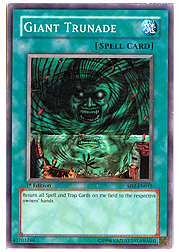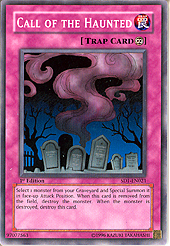The Yu-Gi-Oh! GX animated series isn’t always about the daily life of students at Duel Academia. When Jaden isn’t trying to keep from being expelled by Dr. Vellian Crowler, he’s trying to defeat a duelist of darkness in a shadow game. In reality, that duelist of darkness was hired by Dr. Crowler to defeat Jaden in a duel . . .
Wait—that’s a plot line about trying to get Jaden to leave the school. I guess Titan, the duelist of darkness, is just another way for Dr. Crowler to force Jaden to drop out of Duel Academia. This is what it looks like at first glance, but when Titan makes his debut in the Yu-Gi-Oh! GX animated series during episodes 5 and 6, audiences will discover that there’s a larger plot line to follow.
Titan uses some nasty trickery to get Jaden and his friends into the dueling location of his choice, where he reveals what appears to be a millennium item! The duel begins, and with the power of Titan’s millennium item, he begins a shadow game with Jaden. As Jaden loses life points, portions of his body begin to fade away. The power of Titan’s Archfiend deck appears to be too much for Jaden’s Elemental Heroes to handle. How did Titan come to possess a millennium item? How will Jaden escape this dangerous scenario? What kind of Archfiend deck was Titan running?
Unfortunately for you, you’ll have to wait until Yu-Gi-Oh! GX premieres this fall to find out the answers to those first two questions. However, Titan’s Archfiend deck deserves some analysis, especially since Cybernetic Revolution has added a new monster to the Archfiend line-up.
Cards to Consider
The key card for the Archfiend theme is the field spell known as Pandemonium. It prevents the Archfiend monsters from draining your life points every turn, and it also provides a form of power card advantage, since Pandemonium doubles as both neutralizer and search card for the Archfiend archetype. Titan himself will inform us of this in his initial confrontation with Jaden.
Titan also utilizes the power of Terrorking Archfiend and Infernalqueen Archfiend. Terrorking Archfiend is a hefty level 4 monster who clocks in with the same ATK value as Berserk Gorilla, a Tsukuyomi-hating 1500 DEF, a target-negation effect that can make opponents reconsider their spell options, and an effect negation effect that’s so reminiscent of Dark Balter the Terrible that you can’t help but think that you’re playing the big fusion monster itself*. Infernalqueen Archfiend is normally a small monster, but her effect pumps her own ATK up to 1900 if she’s the only Archfiend monster on your side of the field. However, during your turn, you can use her effect to increase the ATK of any Archfiend monster on your field, including Terrorking Archfiend.
One of the other key cards that Titan uses in his Archfiend deck is Desrook Archfiend. Even when it appeared that Jaden had wiped out Titan’s field of Archfiends, the duelist of darkness merely discarded Desrook Archfiend in order to special summon Terrorking Archfiend for a second attack. Desrook Archfiend provides great synergy with Pandemonium, since most of the monsters that are in the Archfiend deck are higher than level 3. If your opponent destroys Terrorking Archfiend outside of battle, then you’ll have the option to special summon your Archfiend back to the field with Desrook Archfiend, and you can also trigger Pandemonium’s effect to fetch another Desrook Archfiend from your deck.
The final Archfiend monster that Titan utilized was Skull Archfiend of Lightning. This monster’s DEF is barely above the point where it can be easily destroyed by Tsukuyomi, but even if Skull Archfiend’s DEF was less than 1100, the opponent would have to think twice about targeting it with a card effect. While the other Archfiend monsters generally have a one-in-three chance of negating a card that specifically designates that Archfiend as a target, Skull Archfiend of Lighting has a 50 percent chance of negating any card effect that specifically targets it. This turns seemingly powerful cards, such as Tsukuyomi, Snatch Steal, Thousand-Eyes Restrict, and Ring of Destruction into risky gambles that may ultimately cost the opponent valuable cards.
However, some of the newer Archfiend monsters were not used by Titan at all. One of these is the new Cyber Archfiend from Cybernetic Revolution. While this monster is easily destroyed, its effect allows Pandemonium to trigger once you have too many cards in your hand, allowing you to add Desrook Archfiend to your hand as soon as possible. Its DEF is also a valuable asset against heavily aggressive decks.
The other option that Titan didn’t choose is Archfiend of Gilfer, which is a promo card from Shonen Jump magazine. This Archfiend monster has incredibly large stats and one of the highest levels out of all the Archfiends. This turns Archfiend of Gilfer into the deck’s ultimate fetch card when combined with Pandemonium, as it allows you to add almost any Archfiend monster straight from your deck to your hand. Archfiend of Gilfer’s second effect also brings your opponent’s monsters to a level that allows even your weaker monsters to take them out.
Archfiend spell and trap support is relatively limited, since most of the Archfiend-themed cards are either unrewarding or outshined by better cards. However, Archfiend’s Roar is one card that’s worth considering. This trap card gives temporary life to any dead Archfiend of your choice. However, that monster cannot be offered as a tribute and will be destroyed at the end of the turn. The destruction is hardly a downside, since it will trigger Pandemonium and net you another monster from your deck. If your revived monster was a Terrorking Archfiend, then you’ll have the opportunity to trigger Desrook Archfiend’s effect as well.
Making the Deck in Real Life
There are two specific directions that can be taken with the Archfiend deck. The first option is an all-around Archfiend mixture that combines some of Titan’s monsters with some of today’s competitive cards. The other version focuses more on Desrook Archfiend and Terrorking Archfiend, but we’ll look at that build later.
First, here’s a sample build of an Archfiend splash.
Monsters: 18
2 Terrorking Archfiend
2 Infernal Queen Archfiend
2 Desrook Archfiend
1 Skull Archfiend of Lightning
2 Archfiend of Gilfer
1 D.D. Warrior Lady
1 Morphing Jar
1 Breaker the Magical Warrior
1 Tribe-Infecting Virus
1 Sinister Serpent
2 Magician of Faith
1 Black Luster Soldier – Envoy of the Beginning
1 Sangan
Spells: 18
1 Pot of Greed
1 Graceful Charity
1 Heavy Storm
1 Swords of Revealing Light
1 Snatch Steal
1 Mystical Space Typhoon
1 Delinquent Duo
2 Nobleman of Crossout
2 Pandemonium
1 Premature Burial
1 Giant Trunade
2 Scapegoat
1 Metamorphosis
1 Enemy Controller
1 Lightning Vortex
Traps: 4
1 Mirror Force
1 Call of the Haunted
1 Torrential Tribute
1 Ring of Destruction
 This build is pretty standard, with the only exception being the Archfiend splash. The fact that Desrook Archfiend and Terrorking Archfiend have the Light and Dark attributes, respectively, make Black Luster Soldier – Envoy of the Beginning almost a necessary evil in the deck. Giant Trunade specifically acts as removal for a finishing blow, but it also combos with cards such as Premature Burial, Archfiend of Gilfer, and Swords of Revealing Light.
This build is pretty standard, with the only exception being the Archfiend splash. The fact that Desrook Archfiend and Terrorking Archfiend have the Light and Dark attributes, respectively, make Black Luster Soldier – Envoy of the Beginning almost a necessary evil in the deck. Giant Trunade specifically acts as removal for a finishing blow, but it also combos with cards such as Premature Burial, Archfiend of Gilfer, and Swords of Revealing Light.
If you’re looking to have a little more fun with the Archfiends, then take a look at this build. Terrorking Archfiend and Desrook Archfiend are a nasty combination, and the fact that Terrorking Archfiend is special summoned from the graveyard makes recursion a highly abusive factor. This deck turns recursion into the ultimate form of deck thinning and card advantage.
Monsters: 18
3 Terrorking Archfiend
3 Desrook Archfiend
1 Archfiend of Gilfer
1 Skull Archfiend of Lightning
2 Infernalqueen Archfiend
1 Morphing Jar
1 Twin-Headed Behemoth
1 Archfiend Soldier
1 Sangan
1 Dark Necrofear
2 Dark Mimic LV1
1 Dark Mimic LV3
Spells: 16
1 Pot of Greed
1 Graceful Charity
1 Delinquent Duo
1 Heavy Storm
1 Snatch Steal
1 Premature Burial
3 Pandemonium
1 Terraforming
3 Card of Safe Return
1 Lightning Vortex
2 Giant Trunade
Traps: 6
1 Call of the Haunted
2 Archfiend’s Roar
1 Torrential Tribute
1 Ring of Destruction
1 Mirror Force
 This deck’s goal is to draw a ton of cards from the effect of Card of Safe Return, and you have numerous ways to trigger this continuous spell. Premature Burial, Call of the Haunted, Twin-Headed Behemoth, Archfiend’s Roar, and Desrook Archfiend all special summon monsters from the graveyard. With one copy of Card of Safe Return active on the field, you’ll be able to draw cards and maintain card advantage when using your recursion cards.
This deck’s goal is to draw a ton of cards from the effect of Card of Safe Return, and you have numerous ways to trigger this continuous spell. Premature Burial, Call of the Haunted, Twin-Headed Behemoth, Archfiend’s Roar, and Desrook Archfiend all special summon monsters from the graveyard. With one copy of Card of Safe Return active on the field, you’ll be able to draw cards and maintain card advantage when using your recursion cards.
You’ll also be gaining card advantage through the revival of Desrook Archfiend and Archfiend’s Roar, since these trigger Pandemonium as well. If you have two or more copies of Card of Safe Return active, then you’ll be drawing an incredibly large number of cards every time you special summon a monster from the graveyard. Perhaps you’ll be drawing too many cards—but then again, I’m a complete sucker for card drawing combos, so in my mind there’s no such thing as “drawing too many cards.”
The deck itself has only one bomb, which is Dark Necrofear, but the concept is one of the more entertaining themes out there. Those of you who are willing to test this will see that the deck is definitely fun to play.
Titan’s Archfiends definitely have their uses, but can it stand up to Jaden’s Elemental Heroes or Zane “Kaiser” Truesdale’s Cyber Dragons? Find out in the coming weeks, either on television or right here on Metagame.com—and be sure to check out Yu-Gi-Oh! GX, coming this fall to a television near you!
Responses are welcome at Mrosenberg at Metagame dot com.
*The difference is that Dark Balter the Terrible doesn’t like its DEF. Score one for Tsukuyomi!